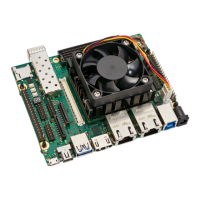Warning!
Depending on the user application, the Mercury XU5 SoC module may consume more power than can
be dissipated without additional cooling measures; always make sure the MPSoC is adequately cooled
by installing a heat sink and/or providing air flow.
2.11.7 Voltage Monitoring
Several pins on the module connector on the Mercury XU5 SoC module are marked as VMON. These are
voltage monitoring outputs that may be used to measure some of the on-board voltages. Examples of such
monitoring circuits are available on Enclustra base boards.
It is not allowed to draw power from the voltage monitoring outputs.
Table 18 presents the VMON pins on the Mercury XU5 SoC module.
Pin Name Module Connector Pin Connection Description
VMON_INT A-102 VCC_INT PL core voltage
VMON_1V2_VBAT B-8 VCC_1V2 1.2 V on-board voltage (default)/MPSoC
battery voltage (assembly option)
VMON_PSINT B-168 VCC_PSINT PS core voltage
VMON_0V9 B-167 VCC_0V9 0.9 V on-board voltage
Table 18: Voltage Monitoring Outputs
2.12 Clock Generation
A 33.33 MHz oscillator is used for the Mercury XU5 SoC module clock generation; the 33.33 MHz clock is
fed to the PS. A 100 MHz LVDS oscillator is connected to FPGA bank 64 and can serve as a reference for the
PLL used to generate the clocks required for the PL DDR interface. The signal is terminated with a 100 Ω
parallel resistor close to the FPGA pins.
A 100 MHz LVDS oscillator and a 27 MHz CMOS oscillator provide reference clock inputs to the PS GTR bank
505. A 24 MHz clock and a 25 MHz clock are used for the USB PHYs and Ethernet PHYs respectively. The
crystal pads for the MPSoC RTC are connected to a 32.768 kHz oscillator on the Mercury XU5 SoC module.
Table 19 describes the clock connections to the MPSoC device.
D-0000-445-001 35 / 64 Version 07, 25.07.2019

